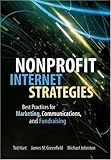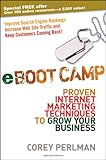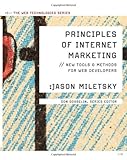|
|
Help |
| Home - Computer - Internet (Books) | |
e99 Online Shopping Mall
|
|
Help |
| Home - Computer - Internet (Books) | |
| Back | 81-99 of 99 |
click price to see details click image to enlarge click link to go to the store
| 81. Inventing the Internet (Inside Technology) by Janet Abbate | |
 | Paperback: 272
Pages
(2000-07-31)
list price: US$27.00 -- used & new: US$17.50 (price subject to change: see help) Asin: 0262511150 Average Customer Review: Canada | United Kingdom | Germany | France | Japan |
|
Editorial Review Product Description "Thoroughly wonderful." -- David Warsh, Boston Globe Since the late 1960s the Internet has grown from a single experimentalnetwork serving a dozen sites in the United States to a network ofnetworks linking millions of computers worldwide. In Inventing theInternet, Janet Abbate recounts the key players and technologiesthat allowed the Internet to develop; but her main focus is always onthe social and cultural factors that influenced the Internet's designand use. The story she unfolds is an often twisting tale ofcollaboration and conflict among a remarkable variety of players,including government and military agencies, computer scientists inacademia and industry, graduate students, telecommunications companies,standards organizations, and network users. The story starts with the early networking breakthroughs formulated inCold War think tanks and realized in the Defense Department's creationof the ARPANET. It ends with the emergence of the Internet and its rapidand seemingly chaotic growth. Abbate looks at how academic and militaryinfluences and attitudes shaped both networks; how the usual linesbetween producer and user of a technology were crossed with interestingand unique results; and how later users invented their own verysuccessful applications, such as electronic mail and the World Wide Web. Peeking behind the curtain to show the personalities and larger forcesguiding the development of the Net, from its dawn as a robust militarycommunications network designed to survive multiple attacks to today'scommercial Web explosion, Abbate succeeds in demystifying thisall-pervasive technology and its creators. Abbate's survey coverseverything from David Baran's work with the RAND corporation to thedevelopment of packet-switching theory to CERN's Tim Berners-Lee andhis hypertext networking system. She also factors in the influencesthat caused the Net to evolve such as the Cold War, changing researchpriorities, and the hacker subculture that pushed existingtechnologies into new forms, each more and more like today's fast,global communications system. The research is impeccable, thewriting is lively, and the analysis is insightful. (See especially thediscussion of the "surprise hit" of ARPANET, a minor function known ase-mail.) Abbate clearly knows her subject and her audience, andInventing the Internet encapsulates a milestone of modernhistory. --Rob Lightner Customer Reviews (10)
Anyway, the book is excellent.Looking forward to more insightful analysis on the history of technology in her upcoming books. ... Read more | |
| 82. Folklore and the Internet: Vernacular Expression in a Digital World | |
 | Paperback: 272
Pages
(2009-09-09)
list price: US$24.95 -- used & new: US$24.94 (price subject to change: see help) Asin: 0874217504 Canada | United Kingdom | Germany | France | Japan |
|
Editorial Review Product Description A pioneering examination of the folkloric qualities of the World Wide Web, e-mail, and related digital media. These stuidies show that folk culture, sustained by a new and evolving vernacular, has been a key, since the Internet's beginnings, to language, practice, and interaction online. Users of many sorts continue to develop the Internet as a significant medium for generating, transmitting, documenting, and preserving folklore. | |
| 83. Internet Core and Computing IC3 Certification Global Standard 3 Study Guide (Certification Press) by Ron Gilster | |
 | Paperback: 686
Pages
(2009-11-18)
list price: US$39.99 -- used & new: US$22.45 (price subject to change: see help) Asin: 0071638113 Average Customer Review: Canada | United Kingdom | Germany | France | Japan |
|
Editorial Review Product Description With hundreds of practice questions and hands-on exercises, IC3 Certification Study Guide covers what you need to know--and shows you how to prepare--for the Internet and Computing Core Certification exams. Covers all the exam topics, including: CD-ROM includes: Ron Gilster, CompTIA A+ Network+. CCNA, is the author of many bestselling books on networking, PC hardware, and IT career certifications, including CEA-CompTIA DHTI+ Digital Home Technology Integrator All-in-One Exam Guide, Second Edition. Customer Reviews (2)
| |
| 84. Internet Politics: States, Citizens, and New Communication Technologies by Andrew Chadwick | |
 | Paperback: 400
Pages
(2006-02-23)
list price: US$49.95 -- used & new: US$24.00 (price subject to change: see help) Asin: 0195177738 Average Customer Review: Canada | United Kingdom | Germany | France | Japan |
|
Editorial Review Product Description Customer Reviews (1)
| |
| 85. Living With the Internet and Online Dangers (Teen's Guides) by Corey Sandler | |
 | Paperback: 176
Pages
(2010-04-30)
list price: US$14.95 -- used & new: US$9.68 (price subject to change: see help) Asin: 0816078750 Canada | United Kingdom | Germany | France | Japan |
|
Editorial Review Product Description | |
| 86. Leonardo to the Internet: Technology and Culture from the Renaissance to the Present (Johns Hopkins Studies in the History of Technology) by Thomas J. Misa | |
 | Paperback: 352
Pages
(2004-03-08)
list price: US$24.00 -- used & new: US$15.97 (price subject to change: see help) Asin: 0801878098 Average Customer Review: Canada | United Kingdom | Germany | France | Japan |
|
Editorial Review Product Description Over eight thematic chapters, Misa provides detailed portraits of the inventors and users oftechnologies. Beginning his narrative at the dawn of the "modern" era, Misa surveys theintersections of technology, politics, and culture in the Renaissance court system of WesternEurope; the role of technology in Holland's commercial expansion; the diverse "paths" to andthrough Britain's industrial revolution; the links among technology, imperialism, and trade in thenineteenth century; and the application of scientific discoveries in chemistry and physics toindustry in Germany and the United States at the turn of the twentieth century. Misa thenexamines the introduction of mass-produced consumer goods and their impact on daily life andmodernist sensibilities; the rise of the military-industrial complex during World War II and thetechnological innovations generated by the command-and-control economies of the Cold War;and the emergence of a technology-oriented global culture since the 1970s. The work concludeswith a provocative essay laying out the technological choices we face today and considering theirimpact on the type of society we wish for the future. A masterful analysis of the ways in which technology and culture have influenced each otherover five centuries, Leonardo to the Internet encourages students and general readersalike to think both more widely and more deeply about the invention, development, transfer, andadaptation of technologies within Western civilization. Customer Reviews (1)
| |
| 87. i-SAFE Internet Safety Activities: Reproducible Projects for Teachers and Parents, Grades K-8 (Jossey-Bass Teacher) by iSafe | |
 | Paperback: 224
Pages
(2010-07-06)
list price: US$29.95 -- used & new: US$17.50 (price subject to change: see help) Asin: 0470539526 Canada | United Kingdom | Germany | France | Japan |
|
Editorial Review Product Description Easy-to-use guide that helps elementary and middle school students develop their Internet skills while keeping safe Most school-age children use the Internet every day. However, many posses na?ve attitudes about their online safety and can inadvertently engage in a range of high-risk behaviors. Developed by i-SAFE™, the leading nonprofit organization dedicated to Internet safety education, this important resource offers a series of fun lessons and teachers' guides to help students in grades K-8 learn how to stay safe online. This is a must-have book that teachers and parents can use to help kids become Internet-savvy. | |
| 88. Nonprofit Internet Strategies: Best Practices for Marketing, Communications, and Fundraising Success by Ted Hart, James M.Greenfield, MichaelJohnston | |
 | Hardcover: 360
Pages
(2005-03-14)
list price: US$39.95 -- used & new: US$21.00 (price subject to change: see help) Asin: 0471691887 Average Customer Review: Canada | United Kingdom | Germany | France | Japan |
|
Editorial Review Product Description Customer Reviews (15)
| |
| 89. Religion Online: Finding Faith on the Internet | |
 | Paperback: 288
Pages
(2004-06-29)
list price: US$34.95 -- used & new: US$23.00 (price subject to change: see help) Asin: 0415970229 Average Customer Review: Canada | United Kingdom | Germany | France | Japan |
|
Editorial Review Product Description Customer Reviews (1)
| |
| 90. eBoot Camp: Proven Internet Marketing Techniques to Grow Your Business by Corey Perlman | |
 | Hardcover: 208
Pages
(2009-01-20)
list price: US$22.95 -- used & new: US$11.95 (price subject to change: see help) Asin: 0470411597 Average Customer Review: Canada | United Kingdom | Germany | France | Japan |
|
Editorial Review Product Description Customer Reviews (56)
| |
| 91. Computer Networking and the Internet (5th Edition) by Fred Halsall | |
 | Hardcover: 832
Pages
(2005-04-02)
list price: US$135.00 -- used & new: US$74.87 (price subject to change: see help) Asin: 0321263588 Average Customer Review: Canada | United Kingdom | Germany | France | Japan |
|
Editorial Review Product Description A clear, current and comprehensive introduction to computer networking from a highly respected author whose previous editions have sold over 240,000 copies ¿ now supported by a rich set of resources in an online study guide. Customer Reviews (1)
| |
| 92. The Online Professor's Practical Guide to Starting an Internet Business by Danielle Babb | |
 | Paperback: 288
Pages
(2009-05-01)
list price: US$21.95 -- used & new: US$12.55 (price subject to change: see help) Asin: 1599183455 Average Customer Review: Canada | United Kingdom | Germany | France | Japan |
|
Editorial Review Product Description Success Support! Youronlineprofessor.com provides a custom, 24/7 support system to ensure your success before and after you build your business! Log on for: Welcome to Online Success 101 From ideas to future growth, successful online professor Dr. Danielle Babb and custom support network youronlineprofessor.com take you step by step to online success, delivering a host of tailor-made online tools, resources, templates, forums, and more with every chapter. Use online quizzes to discover your specialty, establish your business using downloadable forms and templates, streamline operations with real-time support from practicing netpreneurs, spread the word with help from your online network, and more! Let The Online Professor help you: E-commerce, virtual services, online education ... the online opportunities are endless! And the benefits-no startup costs, a world-wide market, setting your own hours, and huge profit potential-are unmatched! Customer Reviews (6)
| |
| 93. The Revolution Will Not Be Televised Revised Ed: Democracy, the Internet, and the Overthrow of Everything by Joe Trippi | |
 | Paperback: 336
Pages
(2008-10-01)
list price: US$15.99 -- used & new: US$6.23 (price subject to change: see help) Asin: 006156107X Average Customer Review: Canada | United Kingdom | Germany | France | Japan |
|
Editorial Review Product Description When Joe Trippi signed on to manage Howard Dean's 2004 presidential campaign, the long-shot candidate had 432 known supporters and $100,000 in the bank. Within a year the most obscure horse in the field was the front-runner, with $50 million in the campaign till, thanks to Trippi and his team. The Revolution Will Not Be Televised is the incredible story of how Joe Trippi's revolutionary use of the Internet forever changed politics as we know it. Trippi's memoir cum manifesto offers a blueprint for engaging Americans in real dialogue—and is an instruction manual for how businesspeople, government leaders, and anyone else can make use of democracy. In a new afterword, Trippi reviews how these lessons have influenced the 2008 campaign, a race marked by higher voter interest than any other in recent history. Customer Reviews (5)
| |
| 94. Internet Information Services (IIS) 7.0 Administrator's Pocket Consultant by William R. Stanek | |
 | Paperback: 576
Pages
(2007-12-29)
list price: US$29.99 -- used & new: US$12.67 (price subject to change: see help) Asin: 0735623643 Average Customer Review: Canada | United Kingdom | Germany | France | Japan |
|
Editorial Review Product Description Delivers must-know details and procedures for administering, supporting and troubleshooting IIS 7.0, including information for performance optimization Features concise tables, easy-to-scan lists, and step-by-step instructions for the answers you need, wherever you need them Customer Reviews (6)
| |
| 95. Exposed: The Harrowing Story of a Mother's Undercover Work with the FBI to Save Children from Internet Sex Predators by R. Stephanie Good | |
 | Hardcover: 256
Pages
(2007-04-03)
list price: US$24.99 -- used & new: US$2.25 (price subject to change: see help) Asin: 1595550623 Average Customer Review: Canada | United Kingdom | Germany | France | Japan |
|
Editorial Review Product Description Customer Reviews (10)
| |
| 96. International Handbook of Internet Research | |
 | Hardcover: 512
Pages
(2010-07-07)
list price: US$269.00 -- used & new: US$215.17 (price subject to change: see help) Asin: 1402097883 Canada | United Kingdom | Germany | France | Japan |
|
Editorial Review Product Description This handbook, the first of its kind, is a detailed introduction to the numerous academic perspectives we can apply to the study of the internet as a political, social and communicative phenomenon. Covering both practical and theoretical angles, established researchers from around the world discuss everything: the foundations of internet research appear alongside chapters on understanding and analyzing current examples of online activities and artifacts. The material covers all continents and explores in depth subjects such as networked gaming, economics and the law. The sheer scope and breadth of topics examined in this volume, which ranges from on-line communities to e-science via digital aesthetics, are evidence that in today’s world, internet research is a vibrant and mature field in which practitioners have long since stopped considering the internet as either an utopian or dystopian "new" space, but instead approach it as a medium that has become an integral part of our everyday culture and a natural mode of communication. | |
| 97. Terror on the Internet: The New Arena, the New Challenges by Gabriel Weimann | |
 | Hardcover: 256
Pages
(2006-03)
list price: US$24.95 -- used & new: US$14.95 (price subject to change: see help) Asin: 1929223714 Average Customer Review: Canada | United Kingdom | Germany | France | Japan |
|
Editorial Review Product Description In this timely and eye-opening volume, Gabriel Weimann reveals that terrorist organizations and their supporters maintain hundreds of websites, taking advantage of the unregulated, anonymous, and accessible nature of the Internet to target an array of messages to diverse audiences. Drawing on a seven-year study of the World Wide Web, the author examines how modern terrorist organizations exploit the Internet to raise funds, recruit members, plan and launch attacks, and publicize their chilling results. Weimann also investigates the effectiveness of counterterrorism measures and warns that this cyberwar may cost us dearly in terms of civil rights. Illustrated with numerous examples taken from terrorist websites, Terror on the Internet offers the definitive introduction to this emerging and dynamic arena. Weimann lays bare the challenges we collectively face in confronting the growing and increasingly sophisticated terrorist presence on the Net. A publication of the United States Institute of Peace, distributed by Potomac Books, Inc. Customer Reviews (7)
| |
| 98. Principles of Internet Marketing: New Tools and Methods for Web Developers (Web Technologies) by Jason I. Miletsky | |
 | Paperback: 644
Pages
(2009-02-02)
list price: US$102.95 -- used & new: US$70.00 (price subject to change: see help) Asin: 1423903196 Average Customer Review: Canada | United Kingdom | Germany | France | Japan |
|
Editorial Review Product Description Customer Reviews (1)
| |
| 99. How to Record Your Own Music and Get it On the Internet (Music Bibles) by Leo Coulter, Richard Jones | |
 | Spiral-bound: 192
Pages
(2009-10-01)
list price: US$14.99 -- used & new: US$9.27 (price subject to change: see help) Asin: 0785825886 Average Customer Review: Canada | United Kingdom | Germany | France | Japan |
|
Editorial Review Product Description Customer Reviews (1)
| |
| Back | 81-99 of 99 |